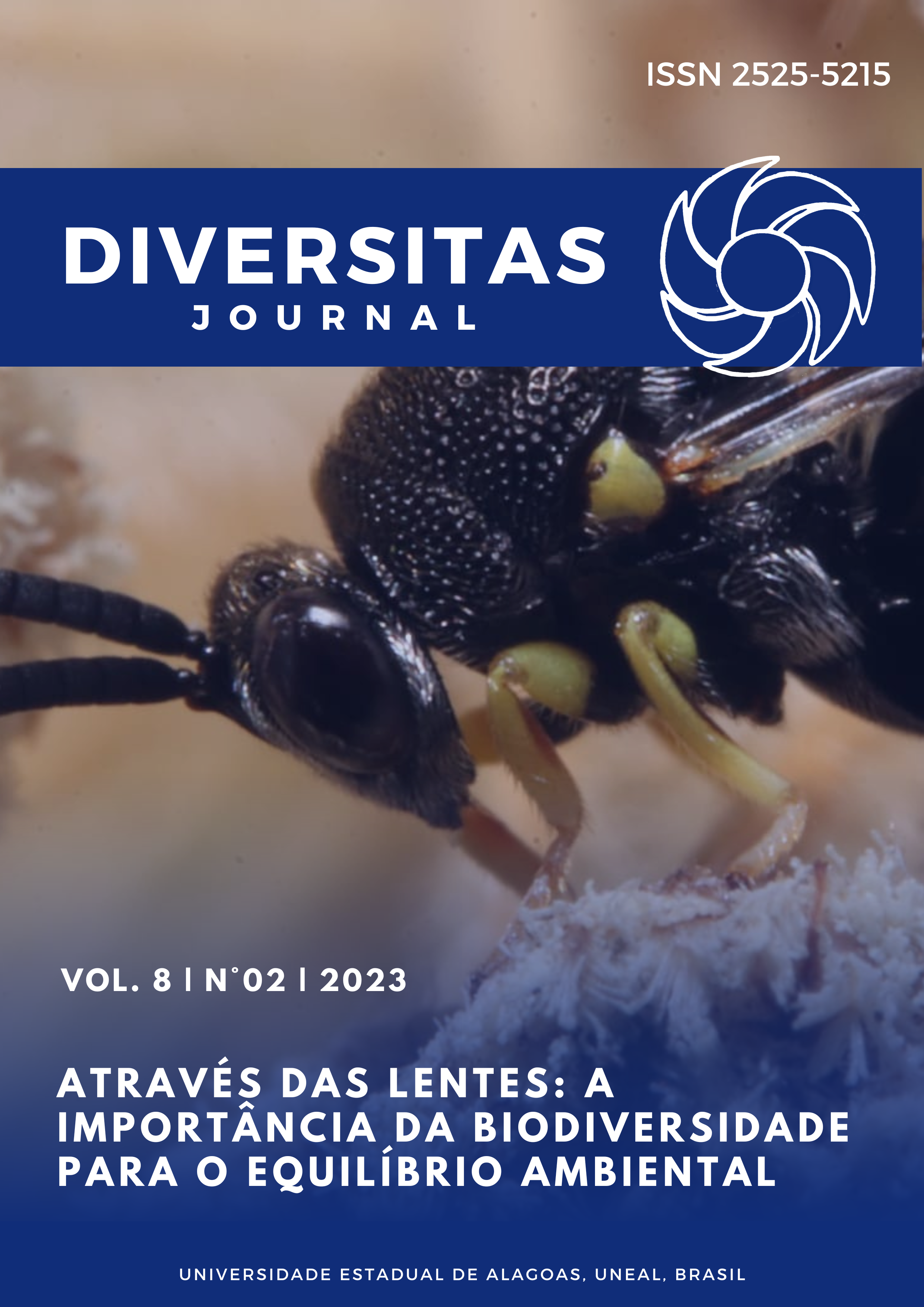Morphological analysis of cabbage (Brassica oleracea L. var. acephala) grown in pots under different manure dosages
DOI:
https://doi.org/10.48017/dj.v8i2.2608Keywords:
Vegetables, greenhouses, organic fertilizer, substratAbstract
Butter cabbage (Brassica oleracea var. acephala) is a vegetable originating from the Mediterranean coast and belongs to the Brassicaceae family. Its consumption in Brazil has increased due to its nutritional properties and different ways of using it in cooking, thus favoring its cultivation in the country. The objective was to analyze the morphological development of cabbage grown in pots in response to different doses of avian manure. The work was conducted from November 2019 to January 2020, in a greenhouse at the State University of Alagoas, Campus I, located in the county of Arapiraca - AL. The experiment was performed DIC (completely randomized design) was carried out using four treatments (T1 - soil without manure, T2 - soil + 50g of manure, T3 - soil + 75g of manure and T4 - soil + 100g of manure) and 5 repetitions. Morphological monitoring was carried out in 12 weeks, initially observing the following variables (pre-harvest): plant height, stem diameter and number of leaves; then, in the post-harvest, the following were evaluated: root length, root fresh mass, plant fresh mass, root dry mass and plant dry mass. All analyzed variables were submitted to analysis of variance, and for comparison of means, the Tukey test was used (p < 0.05). With the results obtained, it was verified that there were no significant differences between the treatments in response to the manure dosages.
Metrics
References
Araújo, A. da S., Silva, D. J. da, Silva, A. V. de S., Magalhães, I. C. S., & Barros, R. P. de. (2018). Análise da fenologia do Girassol (Helianthus annuus L.) variedade anão. Diversitas Journal, 3(2), 184–190. https://doi.org/10.17648/diversitas-journal-v3i2.602
Camargo F., W. P., & Camargo, F. (2009). Análise das alterações na cadeia de produção de hortaliças em São Paulo, 1995-2007. IEA/CATI. Anuários, banco de dados. Disponível em: www. iea. sp. gov. br.
Câmara, G. M. D. S. (2006). Fenologia é ferramenta auxiliar de técnicas de produção. Visão Agrícola, 3(5), 63-66.
Cunha, C., Galo, A. S., Guimarães, N. F., & Silva, R. F. (2014). Substratos alternativos para produção de mudas de alface e couve em sistema orgânico. Scientia Plena, 10 (11).
Filgueira, F. A. R. (2013). Novo manual de olericultura: Agrotecnologia moderna na produção e comercialização de hortaliças. (3a ed). UFV.
Fernandes, D. G. (2017). Sistema automatizado de controle de estufas para cultivo de hortaliças [Trabalho de Conclusão de Curso, Universidade Federal de Santa Maria]. Manancial Repositório Digital da UFSM. https://repositorio.ufsm.br/handle/1/12958?show=full.
Ferreira, D. F. (2011). Sisvar: um sistema computacional de análise estatística. Ciência e agrotecnologia, 35(6), 1039-1042.
Janegitz, M. C., Hermann, E. R. & Matoso, A. (2011). Adubos orgânicos no desenvolvimento inicial de mamoneira em solo corrigido com Calcário. Cascavel 4: 73-82.
Klein, C. (2015). Utilização de substratos alternativos para produção de mudas. Revista Brasileira de Energias Renováveis, 4, 43-63.
Lana, M. M. & Tavares, S. A. (Ed.)(2010). 50 Hortaliças: como comprar, conservar e consumir. 2. ed. rev. Brasília, DF: Embrapa Informação Tecnológica. 209 p. il. color.
Levrero, G. R. R. (2020). Efeito do tipo de fertilizante na produtividade e composição mineral em couve de folha crespa [Trabalho de Conclusão de curso, Universidade Federal de São Carlos, Centro de Ciências Agrárias]. Repositório Institucional UFSCar.
Leite, R. de A., Barros, R. P. de., Oliveira, J. P. S., Cavalcante, J. da S., Santos, D. de S. ., Lima, F. da S., Silva, D. dos S., Sousa, J. I. de, Galdino, W. de O., & Barbosa, J. E. C. (2022). Productivity of sorghum (Sorghum bicolor (L.) Moench) (Poaceae) subjected to different sources of organic fertilization. Research, Society and Development, 11(6), e53211627521. https://doi.org/10.33448/rsd-v11i6.27521.
Pimenta, D. M. (2020). Análise de qualidade agronômica, físico-química e sensorial em couves de folha crespa cultivada com fertilizantes orgânicos [Dissertação de mestrado, Universidade Federal de São Carlos, Campus Araras]. https://repositorio.ufscar.br/handle/ufscar/12879.
Silva, D. J. da., Araújo, A. da S., Silva, A. V. de S., Magalhães, I. C. S., Reis, L. S., & Barros, R. P. de. (2017). Ação inseticida da Morinda citrifolia L. sobre o pulgão Brevicoryne brassicae L. Revista Ambientale, 9(1), 8–13.
Teixeira, M. V., de Oliveira, C. P. M., dos Santos, M. L., Pintar, A. F., & de Oliveira, F. L. (2014). Influência dos nutrientes na formação da massa seca da melancia sem sementes. AGROPECUÁRIA CIENTÍFICA NO SEMIÁRIDO, 10(3), 34-40.
Downloads
Published
How to Cite
Issue
Section
License
Copyright (c) 2023 Livia Gibrinde Barbosa; Rubens Pessoa de Barros, Daniel de Souza Santos, Edlânia Nunes dos Santos, Valdelice Ferreira dos Santos

This work is licensed under a Creative Commons Attribution 4.0 International License.
The Diversitas Journal expresses that the articles are the sole responsibility of the Authors, who are familiar with Brazilian and international legislation.
Articles are peer-reviewed and care should be taken to warn of the possible incidence of plagiarism. However, plagiarism is an indisputable action by the authors.
The violation of copyright is a crime, provided for in article 184 of the Brazilian Penal Code: “Art. 184 Violating copyright and related rights: Penalty - detention, from 3 (three) months to 1 (one) year, or fine. § 1 If the violation consists of total or partial reproduction, for the purpose of direct or indirect profit, by any means or process, of intellectual work, interpretation, performance or phonogram, without the express authorization of the author, the performer, the producer , as the case may be, or whoever represents them: Penalty - imprisonment, from 2 (two) to 4 (four) years, and a fine. ”


















